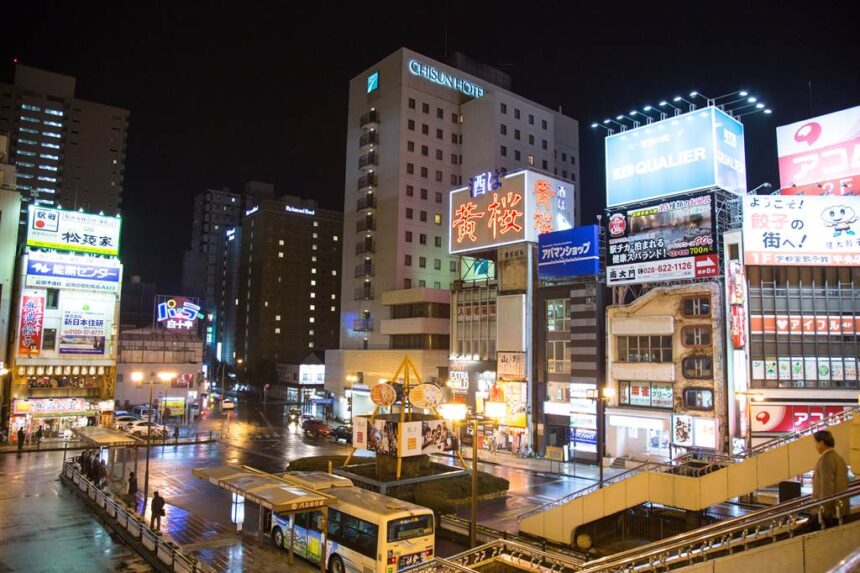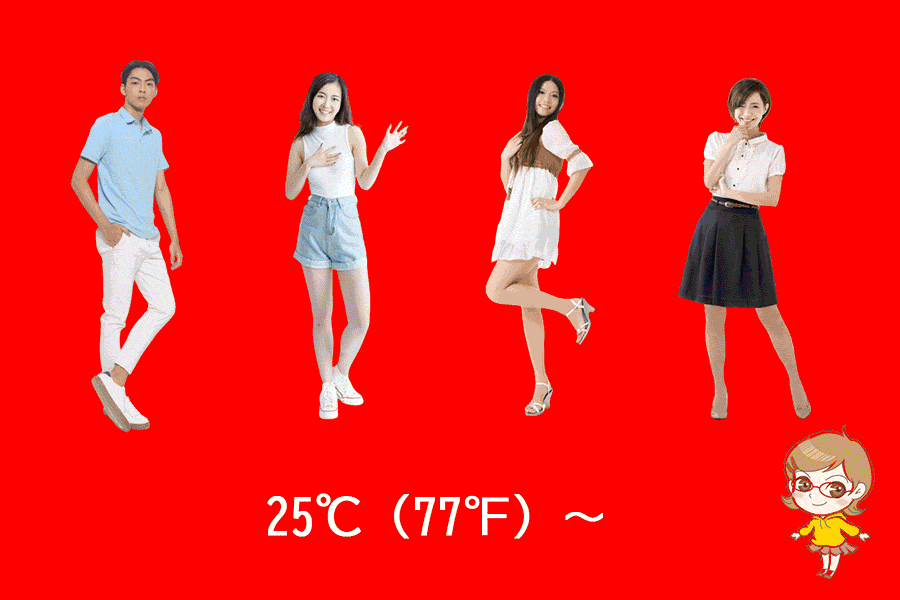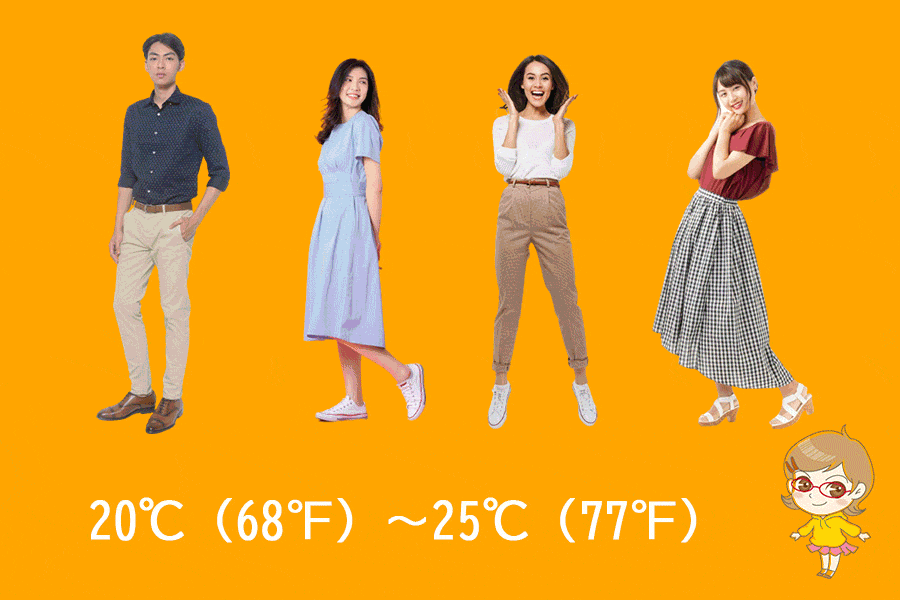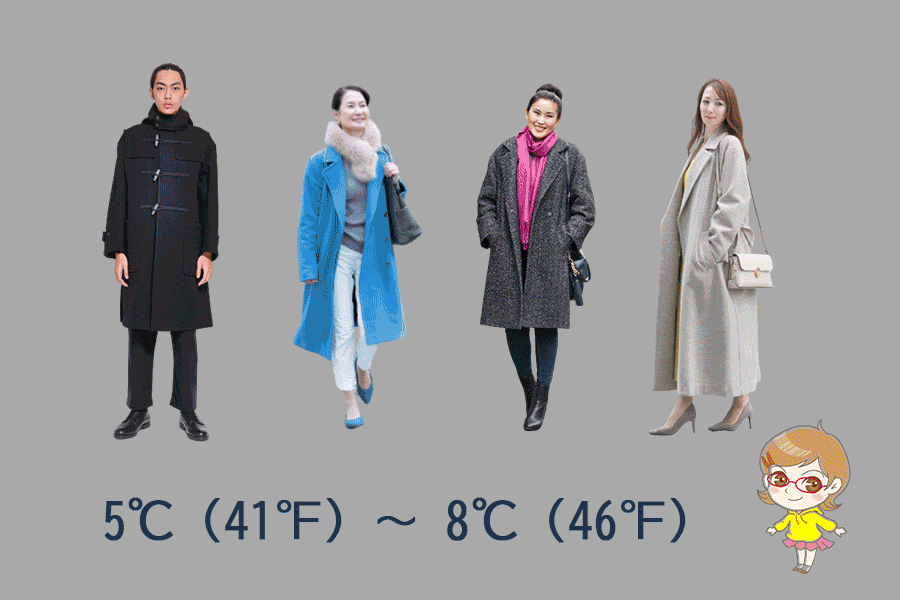1-23 Kawamukocho, Utsunomiya, Tochigi 321-0965 MAP
↓ Click to jump to the relevant section.
| Current Weather | Annual Weather | Tourist Attractions |
| Baggage Deposit | Hotels |
Current weather and clothing

The weather information shown here is the information closest to the station in question. Please note that there may be slight differences.
Yearly temperature changes and recommended clothing
Clothing recommendations for each temperature range
When traveling in Japan with the following average temperatures, the recommended clothing is as follows:
Monthly changes in temperature, precipitation, and snowfall (1991~2020 average, Japan Meteorological Agency survey)
| Jan. | Feb. | Mar. | Apr. | May | Jun. | Jul. | Aug. | Sep. | Oct. | Nov. | Dec. | |
| temperature(°C) | 2.8 | 3.8 | 7.4 | 12.8 | 17.8 | 21.2 | 24.8 | 26 | 22.4 | 16.7 | 10.6 | 5.1 |
| precipitation(mm) | 37.5 | 38.5 | 87.7 | 121.5 | 149.2 | 175.2 | 215.4 | 198.5 | 217.2 | 174.4 | 71.1 | 38.5 |
| snowfall(cm) | 7 | 8 | 2 | 0 | — | — | — | — | — | — | 0 | 1 |
Winter
December
In December, the temperature in Utsunomiya Station drops significantly to around 5°C, and it can snow during this time. The precipitation in December is around 40 mm. For men, warm sweaters or jackets, woolen pants, and boots or closed-toe shoes are essential. It is also recommended to wear gloves, scarves, and hats to keep warm. For women, a combination of sweaters, jackets, warm pants, and boots or closed-toe shoes are ideal clothing options for this time of year. Additionally, women should wear gloves, scarves, and hats to keep warm.
January
The temperature in January is chilly. The average temperature is 2.8°C with occasional snowfall. It is recommended to wear warm clothing such as a heavy coat, a scarf, gloves, and a hat to protect against the cold weather.
February
In February, the temperature remains chilly. The average temperature is 3.8°C. There is still the possibility of snowfall, but it becomes less likely as the month progresses. It is recommended to continue wearing warm clothing such as a heavy coat, a scarf, gloves, and a hat. Layering clothing is also recommended as it allows for flexibility in adapting to the changing weather conditions.
Spring
March
In March, temperatures begin to rise, with an average temperature of 7.4°C. The weather can be quite changeable with occasional rain and strong winds, so it is recommended to wear layers and bring an umbrella or a raincoat. It is still recommended to wear warm clothing, such as a sweater, a light jacket, and a scarf.
April
The average temperature in April is 12.8°C. It is one of the best months to visit Utsunomiya, as the weather is mild and pleasant. Men should wear a light jacket, a sweater, and pants. Women can wear a light jacket, a sweater, and skirts or pants.
May
The average temperature in May is 17.8°C. The weather is pleasant, and it is a great time to enjoy outdoor activities. Men should wear a light jacket, a shirt, and pants. Women should wear a light jacket, a blouse, and skirts or pants.
Summer
June
The average temperature in June is 21.2°C. The weather starts to get warmer, and the humidity increases. Men should wear a light shirt, shorts, and sandals. Women should wear a blouse, shorts, and sandals.
July
The average temperature in July is 24.8°C. Together with August, it is the hottest month of the year, and the humidity is high. Men should wear a t-shirt, shorts, and sandals. Women should wear a blouse, shorts, and sandals.
August
The average temperature in August is 26°C. The weather is still hot and humid. Men should wear a t-shirt, shorts, and sandals. Women should wear a blouse, shorts, and sandals.
Autumn
September
The average temperature in September is 22.4°C. The weather starts to cool down. Men should wear a light jacket, a shirt, and pants. Women can wear a light jacket, a blouse, and skirts or pants.
Please note that typhoons may pass through the Japanese archipelago in September, so please pay attention to the weather forecast.
October
The average temperature in October is 16.7°C. The weather is mild, and it is a great time to enjoy outdoor activities. Men should wear a light jacket, a sweater, and pants. Women can wear a light jacket, a sweater, and skirts or pants.
November
November in Utsunomiya Station marks the onset of winter with the average temperature falling to around 10°C. The precipitation in November is about 71.1mm. For men, warm sweaters or jackets, woolen pants, and boots or closed-toe shoes are recommended. For women, a combination of sweaters, jackets, warm pants, and boots or closed-toe shoes are ideal clothing options for this time of year.
Recommended tourist destinations
Oya History Museum
909 Oyamachi, Utsunomiya 321-0345 Tochigi Prefecture
Visitors can tour a stone mining site that was once in operation. The huge underground space has a fantastic temple-like atmosphere. It is often used as a filming location for TV dramas.
Oya temple
1198 Oyamachi, Utsunomiya 321-0345 Tochigi Prefecture
This is a historic temple built against a rock face that seems to be covered with rocks. The main hall contains 10 Buddhist statues carved into the rock face, which are designated as national important cultural properties.
Utsunomiya Minmin Honten
4-2-3 Babadori, Utsunomiya 320-0026 Tochigi Prefecture
Utsunomiya, the city of gyoza, is lined with many gyoza specialty restaurants. This is one of the most famous among them. You can enjoy grilled gyoza, fried gyoza, and sui-gyoza.
Utsunoiya Futaarayama Jinja Shrine
1-1-1 Babatori, Utsunomiya 320-0026 Tochigi Prefecture
A historic shrine built in the center of Utsunomiya City. The huge torii gate and long stone steps are popular photo spots. There is a fortune shaped like a gyoza (dumpling) in the precincts of the shrine.
Nikko Tosho-gu
2301 Sannai, Nikko 321-1431 Tochigi Prefecture
The shrine is also a mausoleum dedicated to Tokugawa Ieyasu, the first Tokugawa shogun. More than half of the buildings on the vast grounds are national treasures or important cultural properties.The gorgeous and gorgeous buildings, which are the culmination of the craftsmanship of the Edo period, are worth seeing.
Edo Wonderland Nikko Edomura
470-2 Karakura, Nikko 321-2524 Tochigi Prefecture
A theme park that recreates the streets of Edo period (1603-1867). Visitors can experience the culture of the Edo period by experiencing Edo occupations and dressing up in kimono.
Kegon Falls
2479-2 Chugushi, Nikko 321-1661 Tochigi Prefecture
This waterfall is located in Nikko National Park and is one of the three most famous waterfalls in Japan. There is a paid elevator to the viewing area near the basin, where you can get up close enough to feel the spray of the water.
MOBILITY RESORT MOTEGI
120-1 Hiyama, Motegi-machi, Haga-gun 321-3597 Tochigi Prefecture
This mobility theme park is famous for its motorsports circuit track operated by Honda. Located in a natural setting, the park also has athletic facilities and a campground.In addition to allowing visitors to drive their own cars on the circuit, the park is also a mecca for Honda fans, with approximately 300 Honda cars and motorcycles from the past on display in the “Honda Collection Hall.
Mooka Railway
2474-6 Daimachi, Moka 321-4306 Tochigi Prefecture
Visitors can ride on a steam locomotive built in the 1930s. Tickets are sold on weekends and holidays, but advance reservations via the web are recommended. The Mooka Railway SL 96-kan, located next to Mooka Station, has a permanent exhibition of steam locomotives, and visitors can get up close and personal with them.
Ashikaga Flower Park
607 Hasamacho, Ashikaga 329-4216 Tochigi Prefecture
A flower theme park. Especially popular is the largest wisteria trellis in Japan. From mid-April, when the huge wisteria tree, which is over 160 years old, comes into bloom, a purple tunnel is formed, creating a spectacular sight.
Where to leave your luggage
After exiting the ticket gate, go toward the west exit. After taking the escalator down to the first floor, go to the rear left and you will find coin lockers.
Recommended hotels and inns
Richmond Hotel Utsunomiya Ekimae Annex
3-6-5 Ekimaedori, Utsunomiya 321-0964 Tochigi Prefecture
2-minutes walk from Utsunomiya Station
Hotel class: 3
Hotel style:Modern , Centrally Located
Check Rates & Availability:
>> See on Tripadvisor
>> See on Trip.com
>> See on Expedia
JR-East Hotel Mets Utsunomiya
1-23 Kawamukocho, Utsunomiya 321-0965 Tochigi Prefecture
3-minutes walk from Utsunomiya Station
Hotel class: 3
Hotel style:Modern , Mid-range
Check Rates & Availability:
>> See on Tripadvisor
>> See on Trip.com
>> See on Expedia
Daiwa Roynet Hotel Utsunomiya
1-4-14 Higashi Shukugo, Utsunomiya 321-0953 Tochigi Prefecture
4-minutes walk from Utsunomiya Station
Hotel class: 3
Hotel style:Charming , Family
Check Rates & Availability:
>> See on Tripadvisor
>> See on Trip.com
>> See on Expedia
Chisun Hotel Utsunomiya
3-2-3 Ekimaedori, Utsunomiya 321-0964 Tochigi Prefecture
1-minute walk from Utsunomiya Station
Hotel class: 3
Hotel style: Mid-range , Centrally Located
Check Rates & Availability:
>> See on Tripadvisor
>> See on Trip.com
>> See on Expedia
Utsunomiya Tobu Hotel Grande
5-12 Honcho, Utsunomiya 320-0033 Tochigi Prefecture
19-minutes walk from Utsunomiya Station
Hotel class: 3
Hotel style:Family , Business
Check Rates & Availability:
>> See on Tripadvisor
>> See on Trip.com
>> See on Expedia
Chisun Inn Utsunomiya Kanuma
3020-1 Tsurutamachi, Utsunomiya 320-0851 Tochigi Prefecture
2 mi/ 3km from Utsunomiya Station
Hotel class: 3
Hotel style:Charming , Budget
Check Rates & Availability:
>> See on Tripadvisor
>> See on Trip.com
>> See on Expedia
Hotel Sealuck Pal Utsunomiya
5-20-12 Yoto, Utsunomiya 321-0904 Tochigi Prefecture
1.8 mi/ 2.9km from Utsunomiya Station
Hotel class: 3
Hotel style: Business
Check Rates & Availability:
>> See on Tripadvisor
>> See on Trip.com
>> See on Expedia
HOTEL MYSTAYS Utsunomiya
2-4-1 Higashishukugo, Utsunomiya 321-0953 Tochigi Prefecture
4-minutes walk from Utsunomiya Station
Hotel class: 3
Hotel style:Family , Centrally Located
Check Rates & Availability:
>> See on Tripadvisor
>> See on Trip.com
>> See on Expedia
We support your itinerary planning!
Click the button to get an overview of hotel information and popular tourist routes from all over Japan featured on our site. We’ve included comprehensive details to aid in planning your trip, so please make use of it.
Comprehensive checklist before traveling to Japan

Book flights
Compare and purchase flight tickets
When planning your trip to Japan, it's advisable to start by researching flights several months in advance. Airlines often release promotional fares, especially during off-peak seasons. Use comparison sites like Skyscanner or KAYAK to get a sense of the price range. Be flexible with your travel dates if possible; flying mid-week might be cheaper than on weekends.
>> Visit Skyscanner's official website
>> Visit KAYAK's official website
Order Japan Rail Passes for each family member
Purchase your Japan Rail Pass before departure
The Japan Rail (JR) Pass offers unlimited travel on JR trains, making it a cost-effective option for tourists. However, it's only available to foreign tourists and must be purchased *before* you arrive in Japan. Determine the areas you plan to visit; if you're traveling extensively, a nationwide pass is beneficial, but if you're only exploring a specific region, consider regional JR passes. Children under 12 get a discounted pass, so ensure you order the correct type for each family member.
>>Visit Japan Rail Pass's website
Plan your attire for Japan
Check the weather at your destination on this site
Japanese weather varies significantly by season. In summer, it's hot and humid, so breathable clothes are essential. Winters, especially in the north, can be cold, requiring warm attire. If visiting during the rainy season (June to early July), pack a good umbrella and waterproof shoes. While Japan is generally casual, certain places like temples, shrines, or upscale restaurants may require modest and neat dressing.
Reserve a pocket Wi-Fi or SIM card

SIM card or pocket Wi-Fi is required
Beyond clothes, consider packing essentials like a universal power adapter (Japan uses Type A and B sockets), portable Wi-Fi or SIM card for internet access, and any necessary medications (with a copy of the prescription).
Which is better: a SIM card or pocket Wi-Fi?
When traveling in Japan, one essential to consider is securing internet access, especially given that many locations still don't offer free Wi-Fi. To ensure you can use your smartphone throughout your trip, you'll typically have three options: (1) a SIM card, (2) pocket Wi-Fi, or (3) the roaming service provided by your mobile company. Roaming services can be quite expensive, so we often recommend using a SIM card or pocket Wi-Fi. While SIM cards tend to be more affordable than pocket Wi-Fi, they can be trickier to set up. Pocket Wi-Fi, on the other hand, can be shared among several users, making it a favorable choice for families or groups.
▼SIM card
Advantages:
Relatively affordable.
Disadvantages:
Can be time-consuming to set up initially.
May have strict data limits.
▼Pocket Wi-Fi
Advantages:
Offers substantial data allowances.
A single device can be shared among multiple users.
Easily usable with PCs as well.
Disadvantages:
Typically more expensive.
Japan's representative services

Sakura Mobile's website
▼SIM card
>>Visit Sakura Mobile's official website
>>Visit mobal's official website
▼pocket Wi-Fi
>>Visit Sakura Mobile's official website
>>Visit NINJA WiFi's official website
>>Visit Wi-Fi RENTAL Store's official website
Book local tours as needed
Pre-book your tour and have a great trip!
Local tours offer deep insights into Japan's culture and heritage. Websites like Viator or GetYourGuide offer a variety of tours, from traditional tea ceremonies to modern pop culture tours in Akihabara. Consider unique experiences like staying with monks on Mt. Koya or taking a cooking class to learn authentic Japanese dishes.
>>Visit Viator's official website
>>Visit GetYourGuide's official website
Purchase advance tickets for popular attractions
Make a reservation to avoid crowds
Attractions like Tokyo Disneyland, Universal Studios Japan, or the Studio Ghibli Museum often have long ticket queues. Buy tickets online in advance to save time. Some attractions also have timed entry, so check the specific time slots available and plan accordingly.
▼Tokyo Disney Resort
>>Visit Tokyo Disney Resort official website
>>Visit Viator's Tokyo Disneyland page
>>Visit Viator's Tokyo DisneySea page
>>Visit GetYourGuide's Tokyo Disneyland page
>>Visit GetYourGuide's Tokyo DisneySea page
▼Universal Studios Japan
>>Visit USJ official website
>>Visit Viator's USJ page
>>Visit GetYourGuide's USJ page
Buy travel insurance

insurance concept, health, life and travel insurance
It is important to be prepared for emergencies
While Japan is a safe country, travel insurance is crucial for unforeseen events like health emergencies, travel disruptions, or lost baggage. Ensure your policy covers medical expenses in Japan, as healthcare, though excellent, can be expensive.
Here we introduce online travel insurance services that are popular worldwide.
World Nomads: An online travel insurance service widely endorsed by travelers worldwide. They offer plans that cover adventurous activities and high-risk sports.
>>Visit World Nomads' official website
AIG Travel Guard: An insurance service available to travelers all over the world. They offer a wide range of options, including cancellation protection and emergency medical insurance.
>>Visit AIG Travel Guard's official website
Share your itinerary with emergency contacts
Organize your reservation information
Keep a digital and printed copy of your detailed itinerary, including hotel addresses, train schedules, and booked tours. Share this with a trusted family member or friend not traveling with you.














